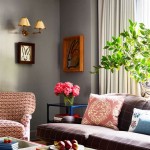Living Room Designs and Colours: A Comprehensive Guide
The living room serves as the central hub of many homes, often the primary space for relaxation, entertainment, and social interaction. Therefore, careful consideration of its design and colour palette is crucial to creating a functional and aesthetically pleasing environment. This article explores various aspects of living room design, focusing on colour psychology and its impact on the overall ambiance and functionality of the space.
Understanding the Fundamentals of Living Room Design
Before delving into colour choices, it's essential to establish a solid foundation in fundamental design principles. This includes understanding the room's dimensions, architectural features, natural light sources, and intended use. A small apartment living room will require a different approach compared to a large, open-plan living area. Careful consideration of furniture placement, traffic flow, and focal points is paramount.
Furniture selection should prioritize both comfort and functionality. A comfortable sofa and sufficient seating are essential, but avoid overcrowding the space. Consider incorporating multi-functional furniture, such as storage ottomans or coffee tables with lift-top mechanisms, particularly in smaller living rooms. Scale is also crucial; oversized furniture can overwhelm a small room, while undersized pieces may look lost in a larger space.
Lighting plays a vital role in setting the mood and enhancing the overall design. A combination of ambient, task, and accent lighting is ideal. Ambient lighting provides overall illumination, while task lighting focuses on specific areas, such as reading nooks. Accent lighting is used to highlight artwork, architectural features, or decorative objects. Natural light should be maximized by strategically placing mirrors and avoiding heavy window coverings.
Texture adds depth and visual interest to a living room. Incorporate different textures through fabrics, rugs, wall coverings, and accessories. Combining smooth and rough textures, such as velvet and linen, or wood and metal, can create a more layered and inviting space. Consider using textured paint or wallpaper to add subtle visual interest to the walls.
The Impact of Colour Psychology in Living Room Design
Colour has a profound impact on human emotions and perception. Choosing the right colour palette for a living room can significantly influence the mood and atmosphere of the space. Understanding the principles of colour psychology is crucial for creating a living room that is both visually appealing and conducive to relaxation and socialization.
Warm colours, such as reds, oranges, and yellows, are associated with energy, excitement, and warmth. These colours can create a cozy and inviting atmosphere, making them suitable for living rooms designed for social gatherings and entertainment. However, using too much of these colours can be overwhelming, especially in smaller spaces. Consider using them as accent colours to add pops of energy and vibrancy.
Cool colours, such as blues, greens, and purples, are associated with calmness, serenity, and relaxation. These colours are ideal for living rooms that are intended for rest and relaxation. Blue is a particularly versatile colour that can evoke feelings of peace and tranquility, making it a popular choice for living rooms. Green is associated with nature and can create a sense of freshness and vitality. Purple can add a touch of luxury and sophistication, but should be used sparingly to avoid creating a gloomy atmosphere.
Neutral colours, such as whites, grays, and beiges, provide a versatile and timeless backdrop for any living room design. These colours are often used as the primary wall colour, allowing for the incorporation of bolder colours through furniture, accessories, and artwork. Neutral colours create a sense of spaciousness and airiness, making them ideal for smaller living rooms or those with limited natural light. They also provide a calming and sophisticated ambiance.
The interplay of light and colour is another crucial factor to consider. The way a colour appears can change dramatically depending on the amount and type of light it receives. Natural light tends to enhance the vibrancy of colours, while artificial light can alter their tone. Before making a final colour decision, it's important to test paint samples in the actual living room under different lighting conditions.
Exploring Different Colour Schemes for Living Rooms
Selecting a cohesive colour scheme is paramount to creating a visually harmonious living room. There are several established colour schemes that can be used as a starting point, each offering a distinct aesthetic and emotional impact.
A monochromatic colour scheme uses different shades and tints of a single colour to create a sophisticated and calming effect. This scheme is particularly effective in smaller living rooms, as it creates a sense of continuity and spaciousness. For example, a monochromatic blue living room could feature walls painted in a light blue, a sofa in a medium blue, and accessories in a darker navy blue.
An analogous colour scheme uses colours that are adjacent to each other on the colour wheel. This scheme creates a harmonious and balanced effect, as the colours naturally complement each other. For example, a living room could feature a colour scheme of blue, blue-green, and green, creating a serene and nature-inspired atmosphere.
A complementary colour scheme uses colours that are opposite each other on the colour wheel. This scheme creates a bold and vibrant effect, as the colours provide a strong contrast. For example, a living room could feature a colour scheme of blue and orange, or red and green. It's important to use one colour as the dominant colour and the other as an accent colour to avoid overwhelming the space.
A triadic colour scheme uses three colours that are equally spaced on the colour wheel. This scheme creates a balanced and harmonious effect, as the colours provide a moderate contrast. For example, a living room could feature a colour scheme of red, yellow, and blue. As with complementary colour schemes, it's important to use one colour as the dominant colour and the other two as accent colours.
Beyond these established colour schemes, consider personal preferences and the overall style of the home. For example, a modern living room might benefit from a minimalist colour scheme of black, white, and gray, while a bohemian living room might incorporate a vibrant mix of colours and patterns.
Practical Considerations for Living Room Colour Selection
Beyond aesthetics and psychology, practical considerations also play a significant role in selecting the right colours for a living room. Factors such as the size of the room, the amount of natural light, and the existing furniture should all be taken into account.
In smaller living rooms, lighter colours are generally preferred, as they create a sense of spaciousness and airiness. Darker colours can make a small room feel even smaller and more enclosed. If darker colours are desired, consider using them as accent colours or in smaller areas, such as a feature wall or decorative accessories.
In living rooms with limited natural light, it's important to choose colours that reflect light and brighten up the space. Avoid using dark or muted colours, which can make the room feel gloomy and depressing. Lighter shades of yellow, orange, and white can help to reflect light and create a more cheerful atmosphere.
The existing furniture and décor should also be considered when selecting a colour palette. Choose colours that complement the furniture and create a cohesive overall look. Consider the colour of the flooring, window coverings, and artwork when making colour decisions. It's often helpful to collect swatches of fabric, paint chips, and other materials to ensure that the colours coordinate well together.
Durability and maintenance are also important factors to consider. Lighter colours tend to show dirt and stains more easily than darker colours. If the living room is frequently used by children or pets, consider choosing a more durable and stain-resistant paint finish. Matte finishes tend to hide imperfections better than glossy finishes, making them a good choice for walls that are not perfectly smooth.

74 Best Living Room Paint Color Ideas For 2025

50 Best Living Room Paint Ideas Colors

Blue Living Room Design Ideas For Your Home Designcafe

74 Best Living Room Paint Color Ideas For 2025
35 Colourful Living Room Ideas And Modern Designs Renoguide N Renovation Inspiration

What Paint Colours To Consider For Your Living Room Design Ovon D

35 Best Paint Colors For Living Rooms

Contemporary Living Room Ideas 10 Trendy Rooms

10 Best Modern Living Room Color Scheme Ideas

3 Simple Living Room Ideas Decorating On A Budget Colourland








